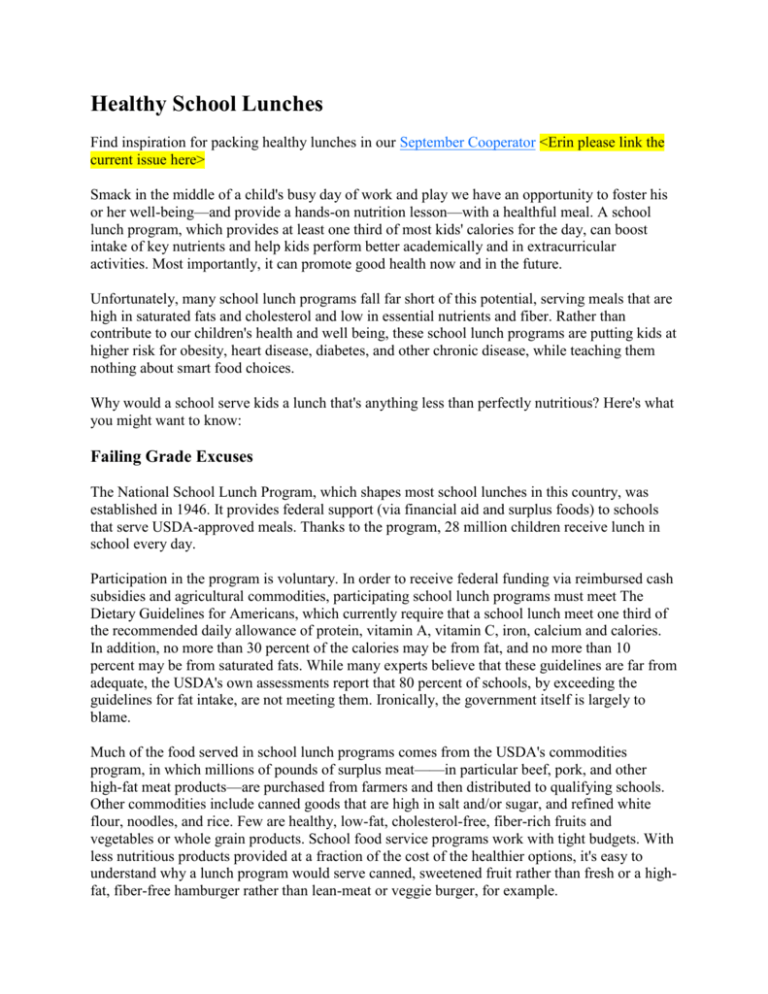Healthy-School-Lunch.. - East End Food Co-op
advertisement

Healthy School Lunches Find inspiration for packing healthy lunches in our September Cooperator <Erin please link the current issue here> Smack in the middle of a child's busy day of work and play we have an opportunity to foster his or her well-being—and provide a hands-on nutrition lesson—with a healthful meal. A school lunch program, which provides at least one third of most kids' calories for the day, can boost intake of key nutrients and help kids perform better academically and in extracurricular activities. Most importantly, it can promote good health now and in the future. Unfortunately, many school lunch programs fall far short of this potential, serving meals that are high in saturated fats and cholesterol and low in essential nutrients and fiber. Rather than contribute to our children's health and well being, these school lunch programs are putting kids at higher risk for obesity, heart disease, diabetes, and other chronic disease, while teaching them nothing about smart food choices. Why would a school serve kids a lunch that's anything less than perfectly nutritious? Here's what you might want to know: Failing Grade Excuses The National School Lunch Program, which shapes most school lunches in this country, was established in 1946. It provides federal support (via financial aid and surplus foods) to schools that serve USDA-approved meals. Thanks to the program, 28 million children receive lunch in school every day. Participation in the program is voluntary. In order to receive federal funding via reimbursed cash subsidies and agricultural commodities, participating school lunch programs must meet The Dietary Guidelines for Americans, which currently require that a school lunch meet one third of the recommended daily allowance of protein, vitamin A, vitamin C, iron, calcium and calories. In addition, no more than 30 percent of the calories may be from fat, and no more than 10 percent may be from saturated fats. While many experts believe that these guidelines are far from adequate, the USDA's own assessments report that 80 percent of schools, by exceeding the guidelines for fat intake, are not meeting them. Ironically, the government itself is largely to blame. Much of the food served in school lunch programs comes from the USDA's commodities program, in which millions of pounds of surplus meat——in particular beef, pork, and other high-fat meat products—are purchased from farmers and then distributed to qualifying schools. Other commodities include canned goods that are high in salt and/or sugar, and refined white flour, noodles, and rice. Few are healthy, low-fat, cholesterol-free, fiber-rich fruits and vegetables or whole grain products. School food service programs work with tight budgets. With less nutritious products provided at a fraction of the cost of the healthier options, it's easy to understand why a lunch program would serve canned, sweetened fruit rather than fresh or a highfat, fiber-free hamburger rather than lean-meat or veggie burger, for example. The government isn't solely to blame for the poor performance of school lunch programs, of course. The influence of the press (including commercial ads shown on Channel One in schools), peer pressure, and the desire to make money all play important roles. Because schools must only meet the government standards for foods that are subsidized, they're free to use fast foods (often served in a la carte menus) and soda and snack food vending machines to raise cash—at the expense of kids' nutrition. Decisions about what to serve in school lunches are made by local school lunch staff, and they're influenced by training, background, availability of food, budget, and personal preferences. The old Food Group model is most often used for meal planning. Because this model centers planning around meat and dairy products, resulting meals are often higher in saturated fats and lower in vitamins and minerals than meals based on more modern, nutrient-based models, which focus on whole grains, vegetables, fruits, and legumes. Needs Improvement Many experts have evaluated school lunch programs, and report cards vary from school to school. In general, the following recommendations surface: School Lunches Need More: Fresh vegetables and fresh and dried fruits; whole grains; legumes. A variety of foods—high in different nutrients; 100 percent fruit juice; fresh water with every meal; calcium-rich, non-dairy milk alternatives, like fortified juices, soymilk, rice milk; foods that are high in fiber, minerals, vitamins and antioxidants; low-fat vegetarian and vegan entrees; low-fat versions of condiments and deli-meats (if offered); healthful snacks such as yogurts, veggies and dip, air-popped popcorn, baked snacks. School Lunches Need Less: Foods that are high in saturated fats, cholesterol, sugar, salt, and calories; refined foods; fried foods; fruit drinks and sodas; meat and poultry. Other recommendations suggest excluding irradiated foods and purchasing organic foods whenever available. And to facilitate healthful eating, the school cafeteria should be a pleasant place to eat, with adequate time allotted for kids to sit and enjoy their lunches. Earn an E for Effort If your child's school lunch program isn't stellar, you can improve its grade. To get going: Eat at school. Evaluate the program. Talk with your child about what he or she likes and doesn't like about school lunches. Explain—in terms that make good sense to your child—why a healthful lunch is such a good idea. (Tell her that she'll run better in track, perform better on her tests, and feel more alert in that afternoon class, for example.) Serve healthful foods at home—for breakfast, for after school snacks, and for dinner. Be a good role model for your child, by eating well yourself both at home and when eating out. Work with other parents and teachers. Join the PTA (which is supportive of improving school lunches) and form a nutrition committee, if your school doesn't already have one. (If it does, they'll be happy for your energy.) Push for healthy lunches as well as programs that teach kids about nutrition. Support food service providers. Tell them you appreciate their work and would like to help make the program the best it can be. (Don't be adversarial.) Contact your district food service director for information and input, too. Talk with the school administration. Explain that you believe that good nutrition for children should be a priority in the school budget. Work to remove fast food, junk food and soda vending machines. Suggest that the school provide training programs for food service workers. Many schools have a wellness policy (relating to physical activity levels as well as nutrition). Ask to see your school's; it will likely state support of your endeavor. Contact your government representatives. Voice your opinion that the federal government should prioritize the health of school children over the subsidization of agribusiness. Tell them that any USDA purchases on behalf of children should foster their health rather than threaten it. A Couple of Good Tutors Citizens for Healthy Options in Children's Education : www.choiceusa.net provides menus, information, support for food service persons, teachers, and parents. "The Healthy School Lunch Campaign,":: http://www.healthyschoollunches.org/ sponsored by the Physicians Committee for Responsible Medicine (PCRM), provides meal planning and recipe ideas, marketing materials, and other support to school and government officials, food service workers, and parents. Article by: © National Cooperative Grocers Association








